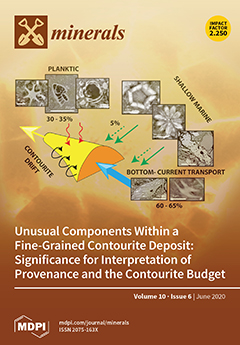In the last 15 years, zeolite-like mayenite, Ca
12Al
14O
33, has attracted significant attention in material science for its variety of potential applications and for its simple composition. Hydrogen plays a key role in processes of electride material synthesis
[...] Read more.
In the last 15 years, zeolite-like mayenite, Ca
12Al
14O
33, has attracted significant attention in material science for its variety of potential applications and for its simple composition. Hydrogen plays a key role in processes of electride material synthesis from pristine mayenite: {Ca
12Al
14O
32}
2+(O
2) → {Ca
12Al
14O
32}
2+(e
−)
2. A presence of molecular hydrogen in synthetic mayenite was not confirmed by the direct methods. Spectroscopy investigations of mayenite group mineral fluorkyuygenite, with empirical formula (Ca
12.09Na
0.03)
∑12.12(Al
13.67Si
0.12Fe
3+0.07Ti
4+0.01)
∑12.87O
31.96 [F
2.02Cl
0.02(H
2O)
3.22(H
2S)
0.15□
0.59]
∑6.00, show the presence of an unusual band at 4038 cm
−1, registered for the first time and related to molecular hydrogen, apart from usual bands responding to vibrations of mayenite framework. The band at 4038 cm
−1 corresponding to stretching vibrations of H
2 is at lower frequencies in comparison with positions of analogous bands of gaseous H
2 (4156 cm
−1) and H
2 adsorbed at active cation sites of zeolites (4050–4100 cm
−1). This points out relatively strong linking of molecular hydrogen with the fluorkyuygenite framework. An appearance of H
2 in the fluorkyuyginite with ideal formula Ca
12Al
14O
32[(H
2O)
4F
2], which formed after fluormayenite, Ca
12Al
14O
32[□
4F
2], is connected with its genesis. Fluorkyuygenite was detected in gehlenite fragments within brecciaed pyrometamorphic rock (Hatrurim Basin, Negev Desert, Israel), which contains reduced mineral assemblage of the Fe-P-C system (native iron, schreibersite, barringerite, murashkoite, and cohenite). The origin of phosphide-bearing associations is connected with the effect of highly reduced gases on earlier formed pyrometamorphic rocks.
Full article





